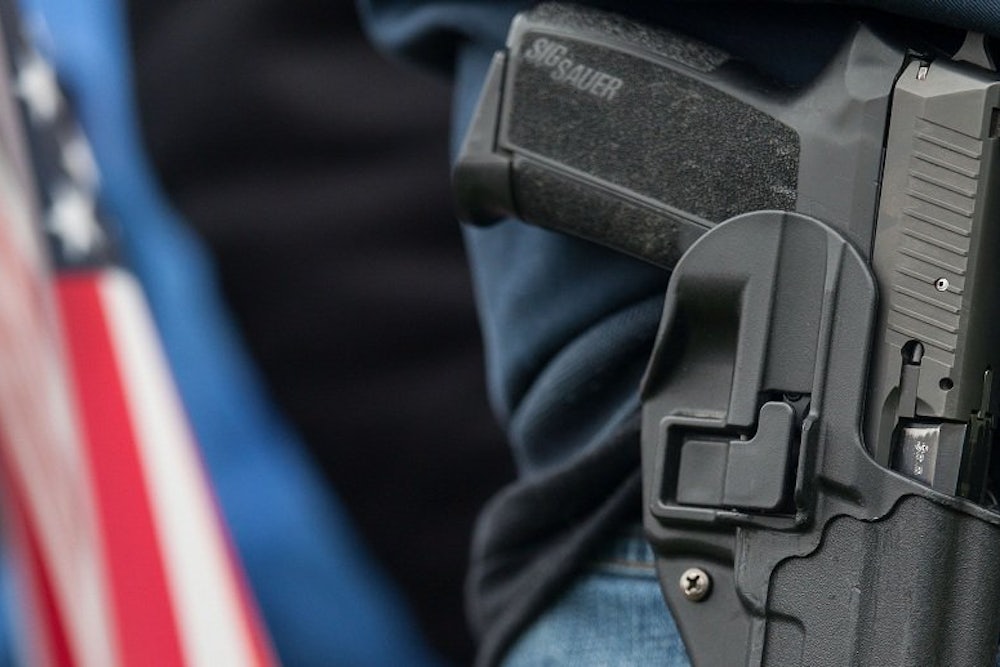The gun I want to talk about wasn’t an assault rifle. It wasn’t purchased illegally. It didn’t fall into the hands of a crazy person. It wasn’t fired in anger. It wasn’t fired by accident. It wasn’t fired for money.
It was fired in fear. So far, our latest national gun dialogue has addressed firepower, on which we’ve agreed to disagree, and personal responsibility, on which we’re set to hear more soon. But there’s a deeper truth about guns. And it has to do with fear.
The gun was a .32-caliber pistol. It belonged to Jolie Blackburn, a 23-year-old graduate student at the University of Texas. On a Monday night in February 1993, Blackburn heard a noise outside her apartment. She went to investigate. She found Anthony Steadman, who was 34, dressed in jogging clothes. According to prosecutors, she yelled, “Get the hell out of here!” And she shot him dead.
Later, court testimony revealed that Steadman, who was estranged from his wife, had been high on marijuana and methamphetamine. His blood alcohol level measured .10 percent. The police found his fingerprints on a bottle outside her window. In a taped interview with investigators, Blackburn described him as “hunching down, trying to look in.” Self-defense, her lawyers argued. They called him a window-peeper. Prosecutors did not contest that characterization.
The case, which I covered as a reporter for the college newspaper, unfolded amid the politics of its day. In Washington, a Democratic president was trying to enact an assault weapons ban over strong opposition led by Wayne LaPierre of the National Rifle Association. The case for a ten-year ban was gaining momentum from a spate of tourist murders in Florida; the massacre of five children at an elementary school in Stockton, California; the use of TEC-9s in a spectacular workplace shooting in San Francisco; and of course the siege on the Branch Davidian compound here in Texas.
At first, Blackburn was charged with involuntary manslaughter. The indictment was thrown out, along with hundreds of others tainted by an ineligible grand juror in the local district attorney’s pursuit of a corruption case. A men’s rights group (those were a big thing at the time) organized a picket line at the courthouse, while victims’ rights groups stood up for the defense. A new grand jury handed up a count of criminally negligent homicide, a more modest charge indicating that Blackburn should have been aware that her actions could cause a man’s death. On top of all that, jurors considered the message their verdict might send in light of a new state law allowing people to carry concealed weapons outside their homes.
In the end, the jury found Blackburn guilty of the reduced charge. No matter the opinions of the various interest groups, the evidence said she had walked outside and shot an unarmed man in the back. “We have to send a signal to people,” one juror told the Austin American-Statesman. “We have to show that you can't just pick up a gun at any time and blow somebody away.”
Since then, there have been more terrifying massacres at Columbine High School, Virginia Tech and Sandy Hook Elementary, to name just a few of the worst. The ban on assault weapons has come and gone. Of the 16,259 homicide deaths counted by the Centers for Disease Control in 2010, the most recent data available, firearms caused 11,078, a little more than two-thirds. The number of deaths prevented by firearms is a matter of speculation.
Meanwhile, gun ownership has declined steadily since the early 1990s, along with the violent crime rate, the murder rate and the percentage of Americans who say they are “afraid to walk alone at night,” according to an analysis of survey statistics by Patrick J. Egan of New York University. But those who do own guns have expanded their rights. Only Illinois and the District of Columbia prevent people from carrying concealed weapons, according to the Government Accountability Office, which counted eight million active permits as of the end of 2011.
All these years later, I can’t help but wonder how things might have turned out that night without the gun, or, more to the point, without the possibility of a gun being kept in a law-abiding private home. A prowler could be fairly certain the young woman behind the window was unarmed. A woman hearing strange noises would have to wait inside for the police. The altered ground rules would almost certainly change the outcome, one way or the other.
So we can talk again later about assault rifles, mental health and video games, about government tyranny and the quiet epidemic of inner city violence, about the sport of hunting and the statistics on firearm accidents in the home. For now, we can talk about background checks, trafficking laws, and school safety response plans.
But let’s be clear: There was not a single item in the Obama Administration’s original proposal, much less what remains on the table, that would even pretend to address the gun Jolie Blackburn used to kill Anthony Steadman. Before we can come to terms with what lies beneath the surface of the debate, we need to tell the truth on ourselves. We are uncertain human creatures who have invented deadly weapons. We live as strangers across a dim window on a cold winter night.
